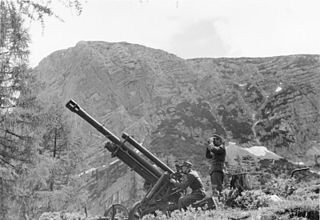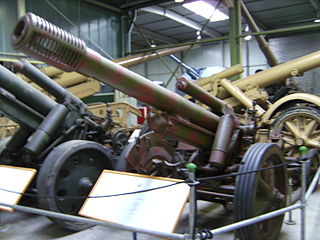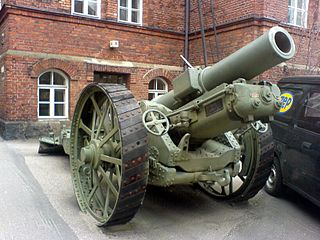 W
WThe 10 cm M. 14 Feldhaubitze was a dual-purpose field and mountain gun used by Austria-Hungary during World War I. Between the wars it was used by Austria, Italy, and Poland. During World War II it served as the standard medium howitzer of the Royal Italian Army with the designation Obice da 100/17 modello 14 and after 1943 captured weapons were used by Nazi Germany's Wehrmacht under the designations 10 cm leFH 14(ö) and 10 cm leFH 315(i). After World War II an updated howitzer remained in service with the Italian Army until 1975.
 W
WThe 10.5 cm Gebirgshaubitze 40 was a 10.5 cm (4.1 in) German mountain howitzer used during World War II. A total of 420 were built during World War II. It saw action with German mountain divisions in Finland, Italy, France, on the Eastern Front and in the Balkans from 1942. It served with a number of European countries into the 1960s.
 W
WThe 10.5 cm leichte Feldhaubitze 16 was a field howitzer used by Germany in World War I and World War II.
 W
WThe 10.5 cm leFH 18 is a German light howitzer used in World War II and the standard artillery piece of the Wehrmacht, adopted for service in 1935 and used by all divisions and artillery battalions. From 1935 to the end of the war, 11,848 were produced, along with 10,265 of the leFH 18/40 variant.
 W
WThe 10.5 cm leFH 18M was a German light howitzer used in the Second World War. The gun, less the carriage and shield, was also used as the armament of the Sd.Kfz. 124 Wespe self-propelled artillery vehicle. It was an improved version of the 10.5cm leFH 18 howitzer that offered superior range.
 W
WThe 15 cm schwere Feldhaubitze 18 or sFH 18, nicknamed Immergrün ("Evergreen"), was the basic German division-level heavy howitzer during the Second World War, serving alongside the smaller but more numerous 10.5 cm leFH 18. Its mobility and firing range and the effectiveness of its 44 kilogram shell made it the most important weapon of all German infantry divisions. A total of 6,756 examples were produced.
 W
WThe 15 cm schwere Feldhaubitze 36 or sFH 36, was a shortened lightweight version of the earlier 15 cm schwere Feldhaubitze 18 that was produced in limited numbers from 1938-1942 and used during World War II.
 W
WThe 24 cm houfnice vz.39 was a Czechoslovak-designed siege howitzer used in the Second World War. It was kept in production after the German occupation of Czechoslovakia in March 1939 and eighteen were delivered to the Germans. It was only used by the Army's Artillery Regiment 814 and entered service shortly before the Battle of France in 1940. The regiment participated Operation Barbarossa and in the Sieges of Sevastopol and Leningrad.
 W
WThe 35.5 cm Haubitze M1 was a German siege howitzer. It was developed by Rheinmetall before World War II to meet the German Army's request for a super-heavy howitzer. Eight were produced between 1939 and 1944. It saw service in the Battle of France and spent the rest of the war on the Eastern Front, saw action in Operation Barbarossa, the siege of Sevastopol, the siege of Leningrad and helped to put down the Warsaw Uprising in 1944.
 W
WThe 122 mm howitzer M1938 (M-30) was a Soviet 121.92 mm (4.8 inch) howitzer. The weapon was developed by the design bureau of Motovilikha Plants, headed by F. F. Petrov, in the late 1930s, and was in production from 1939 to 1955. The M-30 saw action in World War II, mainly as a divisional artillery piece of the Red Army (RKKA). Captured guns were also employed later in the conflict by the German Wehrmacht and the Finnish Army. Post World War II the M-30 saw combat in numerous conflicts of the mid- to late twentieth century in service of other countries' armies, notably in the Middle East.
 W
WThe D-1 howitzer M1943 is a Soviet World War II-era 152.4 mm howitzer. The gun was developed by the design bureau headed by F. F. Petrov in 1942 and 1943, based on the carriage of the 122 mm howitzer M1938 (M-30) and using the barrel of the 152 mm howitzer M1938 (M-10). The powerful and mobile D-1, with its wide range of ammunition, significantly increased the firepower and breakthrough abilities of Red Army tank and motor rifle formations. Several hundred D-1s were manufactured before the end of World War II.
 W
WThe 152 mm howitzer-gun M1937 (ML-20), is a Soviet heavy gun-howitzer. The gun was developed by the design bureau of the plant no 172, headed by F. F. Petrov, as a deep upgrade of the 152-mm gun M1910/34, in turn based on the 152-mm siege gun M1910, a pre-World War I design by Schneider. It was in production from 1937 to 1946. The ML-20 saw action in World War II, mainly as a corps / army level artillery piece of the Soviet Army. Captured guns were employed by Wehrmacht and the Finnish Army. Post World War II, the ML-20 saw combat in numerous conflicts during the mid to late twentieth century.
 W
W203 mm howitzer M1931 (B-4) was a 203 mm (8 inch) Soviet high-power heavy howitzer. During the Second World War, it was under the command of the Stavka's strategic reserve. It was nicknamed "Stalin's sledgehammer" by German soldiers. These guns were used with success against Finnish pillboxes at the Mannerheim Line, heavy German fortifications and in urban combat for destroying protected buildings and bunkers. This weapon was used until the end of the war in the Battle of Berlin where the Red Army would bring these guns up at point blank range to smash German fortifications with their heavy 203mm shells. In the spring of 1944, a KV-1S tank chassis was used to create a self-propelled variant, the S-51. The heavy recoil from the muzzle blast threw the crew off their seats and damaged the transmission, and so it was cancelled.
 W
WThe 240 mm howitzer M1, popularly nicknamed the "Black Dragon", was a towed howitzer used by the United States Army. The 240 mm M1 was designed to replace the World War I era 240 mm howitzer M1918, which was based on a 1911 French design and was outdated by World War II.
 W
WThe 305 mm howitzer M1939 (Br-18) was a Soviet superheavy siege howitzer used by the Soviet Union during World War II. After the Germans occupied Czechoslovakia in March 1939 they took over the Škoda Works, which had been working on this design and a companion 210 mm gun. After a successful test firing 5 July 1939, as a result of the Molotov–Ribbentrop Pact the Germans sold both designs to the Soviet Union. It is not entirely clear that Skoda actually built the weapons itself or merely supplied the blueprints. At any rate, very few weapons seem to have been built; so few, in fact, that there's no record of the Germans capturing any during Operation Barbarossa.
 W
WThe Ordnance BL 6 inch 26cwt howitzer was a British howitzer used during World War I and World War II. The qualifier "26cwt" refers to the weight of the barrel and breech together which weighed 26 long hundredweight (1.3 t).
 W
WThe BL 8-inch howitzer Marks VI, VII and VIII were a series of British artillery siege howitzers on mobile carriages of a new design introduced in World War I. They were designed by Vickers in Britain and produced by all four British artillery manufacturers, but mainly by Armstrong, and one American company. They were the equivalents of the German 21 cm Morser 16 and in British service were used similarly to the BL 9.2-inch howitzer, but were quicker to manufacture, and more mobile. They delivered a 200 lb (91 kg) shell to 12,300 yards (11.2 km). They had limited service in the British Army in World War II before being converted to the new 7.2-inch (180 mm) calibre. They also equipped a small number of Australian and Canadian batteries in World War I and by the US Army in that war. They were used in small numbers by other European armies.
 W
WThe M115 203 mm howitzer, also known as the M115 8 inch howitzer, and originally 8 inch Howitzer M1 was a towed howitzer developed and used by the United States Army.